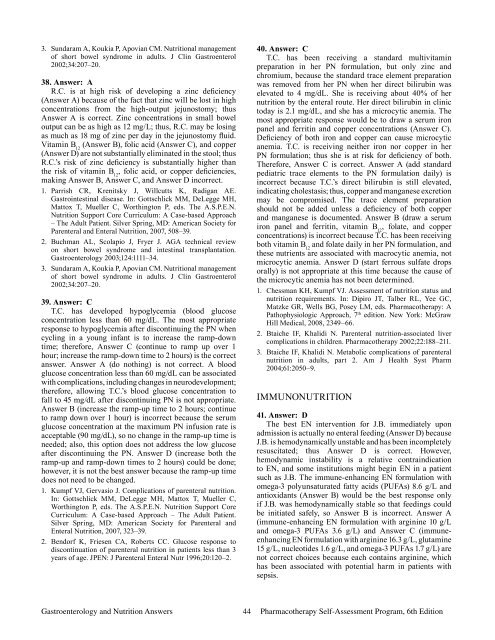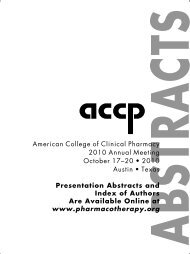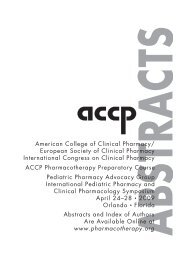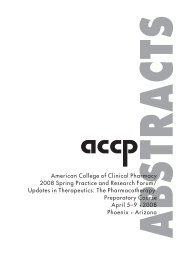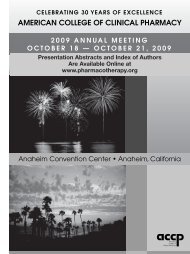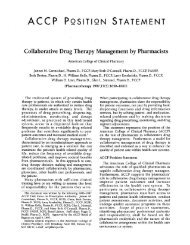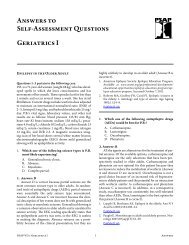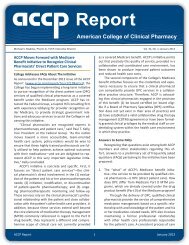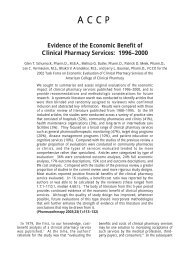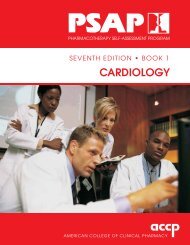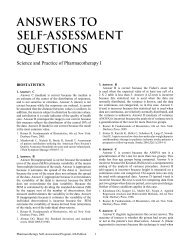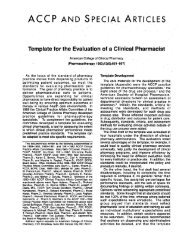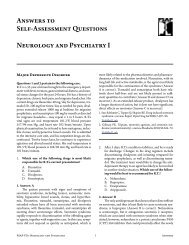Answers to Self-Assessment Questions - ACCP
Answers to Self-Assessment Questions - ACCP
Answers to Self-Assessment Questions - ACCP
Create successful ePaper yourself
Turn your PDF publications into a flip-book with our unique Google optimized e-Paper software.
3. Sundaram A, Koukia P, Apovian CM. Nutritional management<br />
of short bowel syndrome in adults. J Clin Gastroenterol<br />
2002;34:207–20.<br />
38. Answer: A<br />
R.C. is at high risk of developing a zinc deficiency<br />
(Answer A) because of the fact that zinc will be lost in high<br />
concentrations from the high-output jejunos<strong>to</strong>my; thus<br />
Answer A is correct. Zinc concentrations in small bowel<br />
output can be as high as 12 mg/L; thus, R.C. may be losing<br />
as much as 18 mg of zinc per day in the jejunos<strong>to</strong>my fluid.<br />
Vitamin B 12<br />
(Answer B), folic acid (Answer C), and copper<br />
(Answer D) are not substantially eliminated in the s<strong>to</strong>ol; thus<br />
R.C.’s risk of zinc deficiency is substantially higher than<br />
the risk of vitamin B 12<br />
, folic acid, or copper deficiencies,<br />
making Answer B, Answer C, and Answer D incorrect.<br />
1. Parrish CR, Krenitsky J, Willcutts K, Radigan AE.<br />
Gastrointestinal disease. In: Gottschlick MM, DeLegge MH,<br />
Mat<strong>to</strong>x T, Mueller C, Worthing<strong>to</strong>n P, eds. The A.S.P.E.N.<br />
Nutrition Support Core Curriculum: A Case-based Approach<br />
– The Adult Patient. Silver Spring, MD: American Society for<br />
Parenteral and Enteral Nutrition, 2007, 508–39.<br />
2. Buchman AL, Scolapio J, Fryer J. AGA technical review<br />
on short bowel syndrome and intestinal transplantation.<br />
Gastroenterology 2003;124:1111–34.<br />
3. Sundaram A, Koukia P, Apovian CM. Nutritional management<br />
of short bowel syndrome in adults. J Clin Gastroenterol<br />
2002;34:207–20.<br />
39. Answer: C<br />
T.C. has developed hypoglycemia (blood glucose<br />
concentration less than 60 mg/dL. The most appropriate<br />
response <strong>to</strong> hypoglycemia after discontinuing the PN when<br />
cycling in a young infant is <strong>to</strong> increase the ramp-down<br />
time; therefore, Answer C (continue <strong>to</strong> ramp up over 1<br />
hour; increase the ramp-down time <strong>to</strong> 2 hours) is the correct<br />
answer. Answer A (do nothing) is not correct. A blood<br />
glucose concentration less than 60 mg/dL can be associated<br />
with complications, including changes in neurodevelopment;<br />
therefore, allowing T.C.’s blood glucose concentration <strong>to</strong><br />
fall <strong>to</strong> 45 mg/dL after discontinuing PN is not appropriate.<br />
Answer B (increase the ramp-up time <strong>to</strong> 2 hours; continue<br />
<strong>to</strong> ramp down over 1 hour) is incorrect because the serum<br />
glucose concentration at the maximum PN infusion rate is<br />
acceptable (90 mg/dL), so no change in the ramp-up time is<br />
needed; also, this option does not address the low glucose<br />
after discontinuing the PN. Answer D (increase both the<br />
ramp-up and ramp-down times <strong>to</strong> 2 hours) could be done;<br />
however, it is not the best answer because the ramp-up time<br />
does not need <strong>to</strong> be changed.<br />
1. Kumpf VJ, Gervasio J. Complications of parenteral nutrition.<br />
In: Gottschlick MM, DeLegge MH, Mat<strong>to</strong>x T, Mueller C,<br />
Worthing<strong>to</strong>n P, eds. The A.S.P.E.N. Nutrition Support Core<br />
Curriculum: A Case-based Approach – The Adult Patient.<br />
Silver Spring, MD: American Society for Parenteral and<br />
Enteral Nutrition, 2007, 323–39.<br />
2. Bendorf K, Friesen CA, Roberts CC. Glucose response <strong>to</strong><br />
discontinuation of parenteral nutrition in patients less than 3<br />
years of age. JPEN: J Parenteral Enteral Nutr 1996;20:120–2.<br />
40. Answer: C<br />
T.C. has been receiving a standard multivitamin<br />
preparation in her PN formulation, but only zinc and<br />
chromium, because the standard trace element preparation<br />
was removed from her PN when her direct bilirubin was<br />
elevated <strong>to</strong> 4 mg/dL. She is receiving about 40% of her<br />
nutrition by the enteral route. Her direct bilirubin in clinic<br />
<strong>to</strong>day is 2.1 mg/dL, and she has a microcytic anemia. The<br />
most appropriate response would be <strong>to</strong> draw a serum iron<br />
panel and ferritin and copper concentrations (Answer C).<br />
Deficiency of both iron and copper can cause microcytic<br />
anemia. T.C. is receiving neither iron nor copper in her<br />
PN formulation; thus she is at risk for deficiency of both.<br />
Therefore, Answer C is correct. Answer A (add standard<br />
pediatric trace elements <strong>to</strong> the PN formulation daily) is<br />
incorrect because T.C.’s direct bilirubin is still elevated,<br />
indicating cholestasis; thus, copper and manganese excretion<br />
may be compromised. The trace element preparation<br />
should not be added unless a deficiency of both copper<br />
and manganese is documented. Answer B (draw a serum<br />
iron panel and ferritin, vitamin B 12<br />
, folate, and copper<br />
concentrations) is incorrect because T.C. has been receiving<br />
both vitamin B 12<br />
and folate daily in her PN formulation, and<br />
these nutrients are associated with macrocytic anemia, not<br />
microcytic anemia. Answer D (start ferrous sulfate drops<br />
orally) is not appropriate at this time because the cause of<br />
the microcytic anemia has not been determined.<br />
1. Chessman KH, Kumpf VJ. <strong>Assessment</strong> of nutrition status and<br />
nutrition requirements. In: Dipiro JT, Talber RL, Yee GC,<br />
Matzke GR, Wells BG, Posey LM, eds. Pharmacotherapy: A<br />
Pathophysiologic Approach, 7 th edition. New York: McGraw<br />
Hill Medical, 2008, 2349–66.<br />
2. Btaiche IF, Khalidi N. Parenteral nutrition-associated liver<br />
complications in children. Pharmacotherapy 2002;22:188–211.<br />
3. Btaiche IF, Khalidi N. Metabolic complications of parenteral<br />
nutrition in adults, part 2. Am J Health Syst Pharm<br />
2004;61:2050–9.<br />
Immunonutrition<br />
41. Answer: D<br />
The best EN intervention for J.B. immediately upon<br />
admission is actually no enteral feeding (Answer D) because<br />
J.B. is hemodynamically unstable and has been incompletely<br />
resuscitated; thus Answer D is correct. However,<br />
hemodynamic instability is a relative contraindication<br />
<strong>to</strong> EN, and some institutions might begin EN in a patient<br />
such as J.B. The immune-enhancing EN formulation with<br />
omega-3 polyunsaturated fatty acids (PUFAs) 8.6 g/L and<br />
antioxidants (Answer B) would be the best response only<br />
if J.B. was hemodynamically stable so that feedings could<br />
be initiated safely, so Answer B is incorrect. Answer A<br />
(immune-enhancing EN formulation with arginine 10 g/L<br />
and omega-3 PUFAs 3.6 g/L) and Answer C (immuneenhancing<br />
EN formulation with arginine 16.3 g/L, glutamine<br />
15 g/L, nucleotides 1.6 g/L, and omega-3 PUFAs 1.7 g/L) are<br />
not correct choices because each contains arginine, which<br />
has been associated with potential harm in patients with<br />
sepsis.<br />
Gastroenterology and Nutrition <strong>Answers</strong><br />
44<br />
Pharmacotherapy <strong>Self</strong>-<strong>Assessment</strong> Program, 6th Edition


